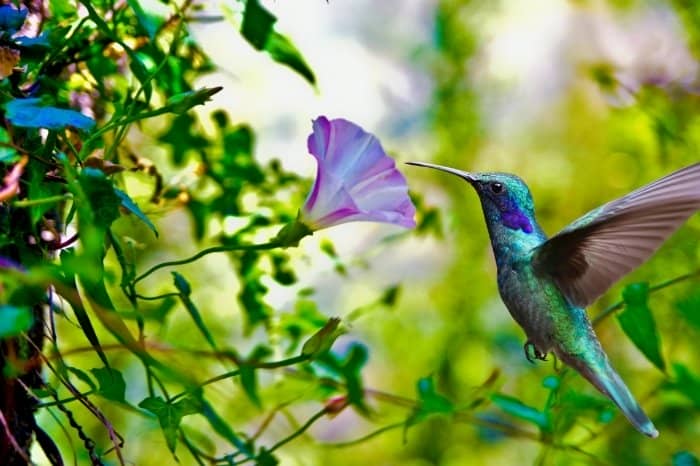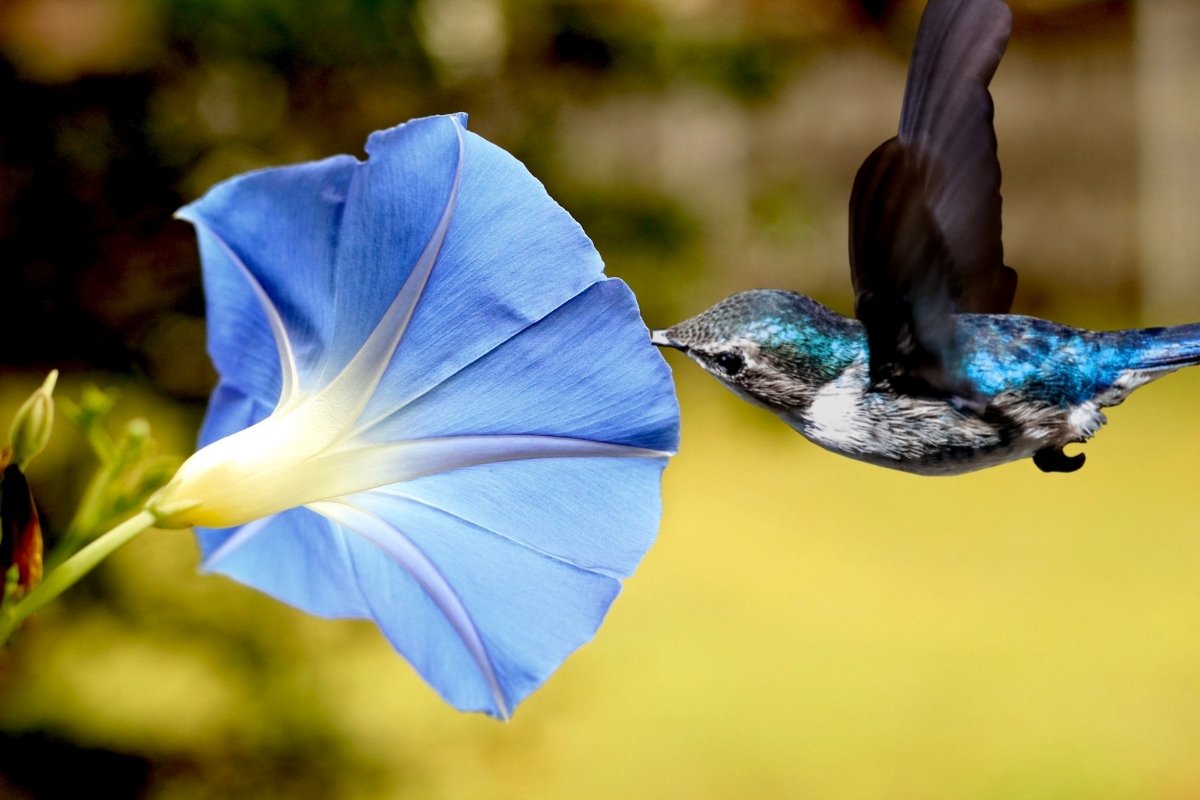Sometimes we plant them, sometimes they grow on their own, but when do morning glory bloom? These tiny trumpet-shaped flowers are known as one of the hummingbird’s favorite nectar sources.
Several reasons make the morning glory attractive to hummingbirds. The plant’s shape and the flowers positioned outward are just a couple of them. Moreover, there are many types of morning glories. What all of them have in common is the flower shape.
Let’s find out when do morning glory bloom and how to make them more accessible to your local hummingbirds.
Morning Glory And Hummingbirds
Hummingbirds love flowers that stretch out of the stem and are easily accessible. The hummers don’t stop to feed; they buzz around the flower going in and out of it. The morning glory is the exact type of flower that hummingbirds look for.
Hummingbirds have long tongues that serve them to slurp the nectar. Therefore, the trumpet-shaped flowers are ideal, as they can accommodate the hummingbird’s long tongue.

Morning glories grow on vines as long as 15 feet. They can be grown as ground covers, perched on walls, fences, or arches in the garden.
When do morning glory bloom is another main reason why hummingbirds love them. The tiny flowers open early in the morning and close as the sunsets. The first buds open in early summer, serving as food for the matting hummingbirds.
Check Out 9 Fascinating Paintings Of Hummingbirds And Flowers
Important Facts About Morning Glory
These fast-growing flowers are not everyone’s favorite. While hummingbirds love them, gardeners tend to keep them away. Let’s see what interesting facts these tubular flowers have in store.
1. Morning Glory Blooms During Hummingbird Migration
When do morning glory bloom depend on the last frost date. They’re sensitive to low temperatures, so they tend to bloom in early summer. The flowers stay until the first fall frost. But does morning glory bloom all summer? Yes, they do!
The hummingbirds can snack on them until fall, or until they decide to migrate to the warmer spots of Central America.
2. Morning Glory And Hummingbirds Share A Daily Schedule
Morning glory flowers open up every morning when the sun rises. They close when the sunsets. Sounds familiar? This is the same schedule that hummingbirds follow!
Hummingbirds wake up at dawn and start looking for food right away. The morning glory has just opened, so it’s welcoming the early birds. The hummers go into torpor at dusk, and at the same time, the morning glory flowers close.

3. They’re Annual In Cold Climates
You probably wonder do morning glories come back year after year? These flowers are annuals in cold climates but perennial in the warmer states.
Morning glory loves warmth and sun, just like the hummingbirds.
Read more about How To Keep Raccoons Out Of Hummingbird Feeders?
4. Sweet Potatoes Are Morning Glory
Sweet potatoes belong to the morning glory family. While we consume the delicious tubular root, the hummingbirds devour the purple and white flowers. Plus, the hummingbirds help pollinate the sweet potatoes.
5. Morning Glory Seeds Are Toxic
Hummingbirds are smart, and the morning glory seeds are proof. Unfortunately, these seeds contain a chemical equivalent to LSD, poisonous to birds, pets, and humans.
The morning glory multiplies by producing seeds at the end of the season. The seed sacks burst, and the seeds fall to the ground. A new plant emerges the following summer.
If you don’t want this plant spreading, observe when do morning glory bloom and cut the dead flowers before they drop their seeds.
Where To Plant Morning Glory
You can plant morning glories from seeds as soon as the soil warms up to 65°F. Unfortunately, the seeds won’t germinate in cold soil. So how late can morning glories bloom if they can’t tolerate the cold? The blooms are safe until the fall temperatures start to drop and the first frost appears.
Muse Garden Hummingbird Feeder for Outdoors, Hand Blown Glass, 25 Ounces
Pick a sunny and sheltered spot, or the morning glory won’t bloom. When do morning glory bloom if they’re exposed to winds? The morning glory will bloom, but the vines are not very thick, so winds might break them. Also, hummingbirds prefer to visit sheltered flowers.
You can even train the vine to climb a wall of your house. This way, it also provides insulation and keeps your home cool. As a bonus, you can see the hummingbirds feeding on the blooms from the comfort of your couch.
Click Here to Learn:
Types Of Morning Glory
Before you set off to purchase morning glory seeds, you need to learn the difference between the types. When do morning glory bloom depend on its type. Some morning glories are invasive, and you can spend months dealing with persistent roots.
The best type you can choose for your hummingbirds is the Cardinal Climber. This plant is also known as the hummingbird vine. It features bright red tubular flowers and thrives in shady spots. Wondering when do morning glory bloom? This vine blooms from early summer until late fall.
The Scarlett O’Hara morning glory has slightly larger, fuchsia-colored flowers with a white center. It loves sunny spots and moisture.
The Heavenly Blue morning glory has deep blue flowers with a yellow center, making it attractive for the hummingbirds.
There’s a common answer to what month do morning glory flowers bloom, and it’s early summer. In warmer climates, it can be May; in others, it can be June.
Bottom Line: When Do Morning Glory Bloom?
A trellis of morning glory is one of the best flowers you can plant for your annual visitors. The hummingbirds love the trumpet-shaped flowers. They’re attracted by their bright colors, shape, and the fact that they open early in the morning.
But when do morning glory bloom? From early summer until late fall, your hummingbirds can resort to these flowers for their daily nectar. Pick some of their favorite types and create a real hummingbird haven in your garden.
FAQs
[rank_math_rich_snippet id=”s-7d324e0f-53bb-4d23-88e0-2b72167e8532″]


